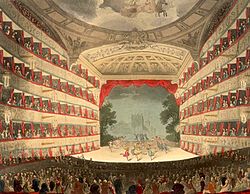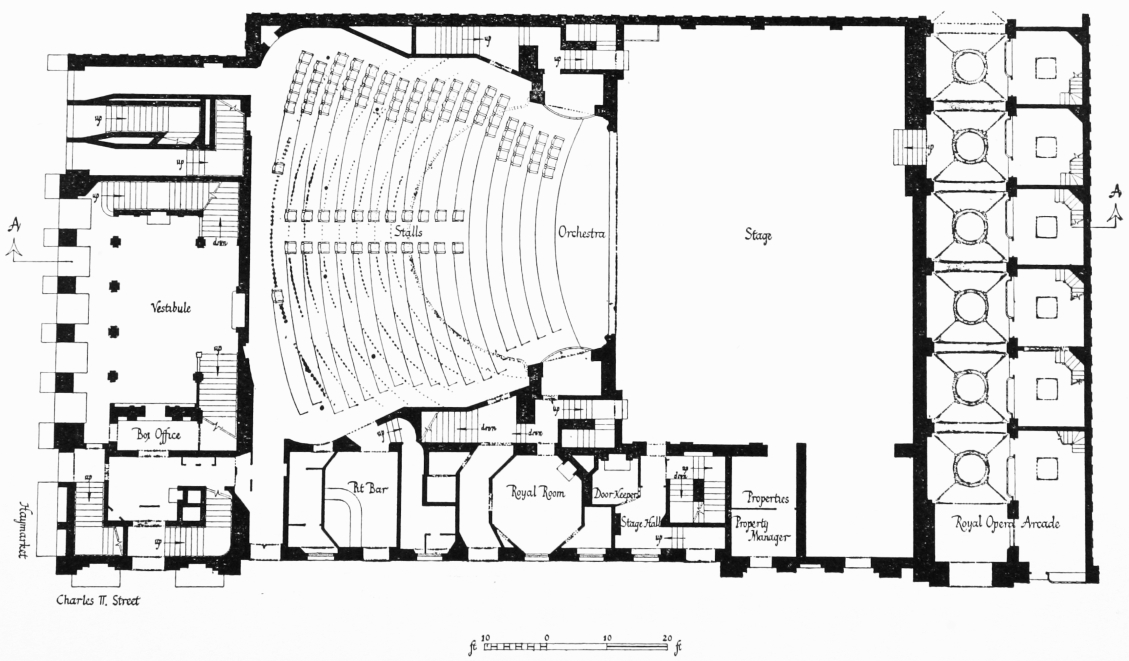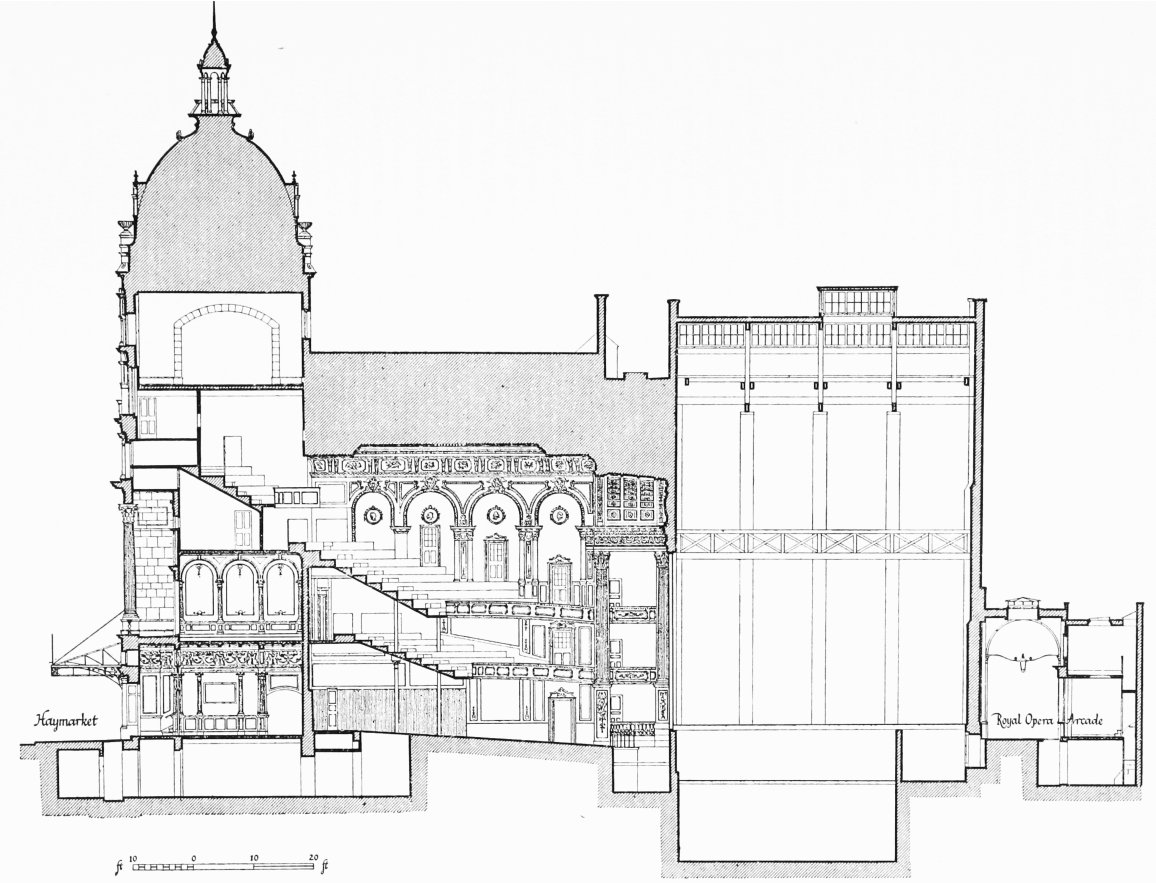 Today a prominent theater in London is the the Haymarket Opera house, also known as the Queen’s theater which has shown critically-acclaimed, Broadway-style productions such as Les Miserables and Phantom of the Opera. This theatre has a long history from the time of Queen Anne. It has gone by many names: the Queen’s, the King’s, Her Majesty’s, His Majesty’s, and even simply, The Opera House.
Today a prominent theater in London is the the Haymarket Opera house, also known as the Queen’s theater which has shown critically-acclaimed, Broadway-style productions such as Les Miserables and Phantom of the Opera. This theatre has a long history from the time of Queen Anne. It has gone by many names: the Queen’s, the King’s, Her Majesty’s, His Majesty’s, and even simply, The Opera House.
In 1789, this theatre suffered near-total destruction due to a fire believed to be set by a disgruntled ex-employee. It again suffered that same tragedy in 1867. Each time, it was rebuilt. In 1890’s it was demolished and rebuilt to include “modern” features. Today, it is still decorated with a definite flair for the Edwardian Era.
The theatre’s financial success has undergone the same turbulence as its structure. Initially, the Opera realized only modest success in London, and it faced closures on and off throughout its existence. It wasn’t until Handel performed that such entertainment became popular. Between 1785 and 1830, if featured works by sixteen different composers.
Operas and ballets were performed in this theatre, and soon going to the theatre became a fashionable pastime for the rich and poor alike, with seating to accommodate every income level. Those wealthy enough to purchase seats in the boxes were spared having the sit with those of the lower classes, which, of course, members of the beau monde would have found intolerable. Over time, going to the theatre to see and be seen became more important than watching the production and there are numerous reports of the audience noise level being so loud that one could hardly hear the music or singing.
 Not every Opera house had an orchestra pit, but this was did as of a remodeling 1782. In addition to adding the pit, stage was reduced in depth to add length to an auditorium planned on the conventional lines of an Italian opera house, with a large pit and five shallow tiers of horseshoe form.
Not every Opera house had an orchestra pit, but this was did as of a remodeling 1782. In addition to adding the pit, stage was reduced in depth to add length to an auditorium planned on the conventional lines of an Italian opera house, with a large pit and five shallow tiers of horseshoe form.
According to British History Online:
George Saunders, in his Treatise on Theatres (1790), describes the building at this stage of its existence. ‘The form was then made an oblong rounded off at the end opposite the stage. The length was, from the stage-front [apron] to the opposite boxes, about 58 feet, and 23 feet more to the scene; the breadth between the boxes 43 feet; and the height 44 feet from the centre of the pit to the ceiling. There were three ranges of boxes, 34 in each range, besides 18 in a line with the gallery; in all 116, allowing the space of two for entrances into the pit. Each box was from 5 to 6 feet wide, from 7 to 7 feet 6 inches high, and 6 feet deep.’
 ‘…a chain of foyers extended across the north end. The carriage entrance was in the Haymarket, where patrons passed through a vestibule into an apse-ended hall containing the grand staircase. The short middle flight descended to the pit and the two side flights ascended to the second-tier level, where the horseshoe corridor serving the principal boxes was approached by way of two linked foyers, an octagon and a rotunda, the last centred on the main axis of the auditorium. West of the rotunda was an oblong hall containing the staircase from the chairs’ entrance in Market Lane. All the box corridors were served by two staircases, rising in semi-circular wells formed in the north-east and north-west spandrels. The ‘portrait’ plan shows secondary staircases of spiral form at the proscenium end of the corridors, but these, if built, would have been demolished in 1796 when the auditorium was lengthened. Novosielski’s original arrangement of the auditorium is shown in an engraved ‘Plan of the Boxes of the New King’s Theatre—September 1790’. (fn. 206) There were five closely spaced tiers of horseshoe form, the first three each divided into 37 boxes. The fourth tier contained the gallery with 13 boxes on each side. The central part of the fifth tier was omitted to give headroom for the gallery, and each arm contained 13 boxes. In all, there were 163 boxes in the tiers, and 8 pit-boxes on each side of the capacious pit.’
‘…a chain of foyers extended across the north end. The carriage entrance was in the Haymarket, where patrons passed through a vestibule into an apse-ended hall containing the grand staircase. The short middle flight descended to the pit and the two side flights ascended to the second-tier level, where the horseshoe corridor serving the principal boxes was approached by way of two linked foyers, an octagon and a rotunda, the last centred on the main axis of the auditorium. West of the rotunda was an oblong hall containing the staircase from the chairs’ entrance in Market Lane. All the box corridors were served by two staircases, rising in semi-circular wells formed in the north-east and north-west spandrels. The ‘portrait’ plan shows secondary staircases of spiral form at the proscenium end of the corridors, but these, if built, would have been demolished in 1796 when the auditorium was lengthened. Novosielski’s original arrangement of the auditorium is shown in an engraved ‘Plan of the Boxes of the New King’s Theatre—September 1790’. (fn. 206) There were five closely spaced tiers of horseshoe form, the first three each divided into 37 boxes. The fourth tier contained the gallery with 13 boxes on each side. The central part of the fifth tier was omitted to give headroom for the gallery, and each arm contained 13 boxes. In all, there were 163 boxes in the tiers, and 8 pit-boxes on each side of the capacious pit.’
In my book, Heart Strings, I take a deeper look at the lives of those who performed in the King’s Theatre through the eyes of my hero and heroine who are musicians in the orchestra.
Here is the backcover blurb from my newest novel, Heart Strings:
 Gently bred young ladies don’t run away from home to find employment, but when forced to choose between marrying a brutish oaf or becoming another man’s mistress, Susanna makes an unconventional decision. Following her passion for music, she flees to London with dreams of securing a position as a harpist. Becoming entangled with a handsome violinist who calls himself Kit, but who seems more an aristocrat than an ordinary musician, may be even more problematic than sleeping in the streets. Kit’s attention is captured by Susanna’s breath-taking talent, admirable grace, and winsome smiles…until a lawman exposes the new harpist both a runaway bride and a thief. Now Kit must not only choose between his better judgement and his heart, but must also embrace the life to which he swore he’d never return.
Gently bred young ladies don’t run away from home to find employment, but when forced to choose between marrying a brutish oaf or becoming another man’s mistress, Susanna makes an unconventional decision. Following her passion for music, she flees to London with dreams of securing a position as a harpist. Becoming entangled with a handsome violinist who calls himself Kit, but who seems more an aristocrat than an ordinary musician, may be even more problematic than sleeping in the streets. Kit’s attention is captured by Susanna’s breath-taking talent, admirable grace, and winsome smiles…until a lawman exposes the new harpist both a runaway bride and a thief. Now Kit must not only choose between his better judgement and his heart, but must also embrace the life to which he swore he’d never return.
Available on Amazon.
Sources:
British History Online
Theatre Historian, Margaret Evans Porter
